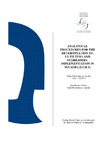Please use this identifier to cite or link to this item:
https://accedacris.ulpgc.es/jspui/handle/10553/77714
| DC Field | Value | Language |
|---|---|---|
| dc.contributor.advisor | Sosa Ferrera, María Zoraida | es |
| dc.contributor.advisor | Montesdeoca Esponda, Sarah | es |
| dc.contributor.author | Garrigós Alcalá, Nuria Alicia | es |
| dc.date.accessioned | 2021-02-12T11:08:27Z | - |
| dc.date.available | 2021-02-12T11:08:27Z | - |
| dc.date.issued | 2021 | - |
| dc.identifier.uri | https://accedacris.ulpgc.es/handle/10553/77714 | - |
| dc.description.abstract | Microplastic contamination is already a worldwide problem to which the issue of adsorbed contaminants must be added. These substances can cause physical, chemical and biological internal damage and negative impacts on the metabolism of organisms. An increase in the investigation on the topic of adsorbed contaminants on microplastics is needed to developed techniques that can effectively extract them, especially emerging contaminants, since there is not much literature on the subject matter. Among these emerging contaminants, there are personal care products, hydrophobic and with a high affinity for plastic surfaces, which are divided into disinfectants, synthetic fragrances, parabens, UV protection compounds and antioxidants. In this work, different techniques used for the extraction of UV filters and stabilizers from environmental solid samples, like Soxhlet, Vortex extraction (VE), Ultrasonic extraction (USE), Microwave assisted extraction (MAE), Pressurized liquid extraction (PLE), Matrix solid phase dispersion (MSPD) and Quick, Easy, Cheap, Effective, Rugged, and Safe (QuEChERS), are compared. They are then discussed regarding their application to microplastic matrices. After comparing the advantages and disadvantages of each one, we determined that USE and MSPD are the ones that seem to be the overall better suited for this end. Both techniques can be implemented for the different types of microplastic polymers since neither is temperature dependent and both present high recoveries in the available literature, but further research for MSPD is needed. | en_US |
| dc.language | eng | en_US |
| dc.subject | 2301 química analítica | en_US |
| dc.subject.other | Microplastics | es |
| dc.subject.other | UV filters | es |
| dc.title | Analytical procedures for the determination of UV filters and stabilizers. Implementation in microplastics | es |
| dc.type | info:eu-repo/semantics/masterThesis | en_US |
| dc.type | MasterThesis | en_US |
| dc.contributor.departamento | Departamento de Química | es |
| dc.contributor.facultad | Facultad de Ciencias del Mar | en_US |
| dc.investigacion | Ciencias | en_US |
| dc.type2 | Trabajo final de máster | en_US |
| dc.description.notas | Máster en Oceanografía ; 2020-2021 | en_US |
| dc.utils.revision | Sí | en_US |
| dc.identifier.matricula | TFT-57257 | es |
| dc.identifier.ulpgc | Sí | en_US |
| dc.contributor.buulpgc | BU-BAS | es |
| dc.contributor.titulacion | Máster Universitario en Oceanografía por la Universidad de Cádiz, la Universidad de Las Palmas de Gran Canaria y la Universidad de Vigo | es |
| item.fulltext | Con texto completo | - |
| item.grantfulltext | open | - |
| crisitem.advisor.dept | GIR IUNAT: Análisis Químico Medioambiental | - |
| crisitem.advisor.dept | IU de Estudios Ambientales y Recursos Naturales | - |
| crisitem.advisor.dept | Departamento de Química | - |
| crisitem.advisor.dept | GIR IUNAT: Análisis Químico Medioambiental | - |
| crisitem.advisor.dept | IU de Estudios Ambientales y Recursos Naturales | - |
| crisitem.advisor.dept | Departamento de Química | - |
| Appears in Collections: | Trabajo final de máster | |
Page view(s)
371
checked on Jan 18, 2025
Download(s)
433
checked on Jan 18, 2025
Google ScholarTM
Check
Share
Export metadata
Items in accedaCRIS are protected by copyright, with all rights reserved, unless otherwise indicated.
